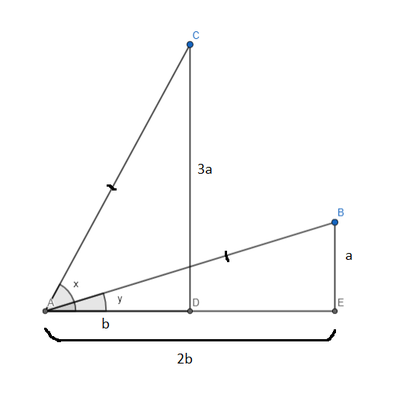Difference between revisions of "2012 AIME II Problems/Problem 9"
(→See Also) |
m (→Solution 3) |
||
| Line 77: | Line 77: | ||
The first term is <math>\frac{3}{2}</math>, refer to solution 1 for how to find it. | The first term is <math>\frac{3}{2}</math>, refer to solution 1 for how to find it. | ||
| − | The second term is <math>\frac{cos^2(x) - sin^2(x)}{cos^2(y) - sin^2(y)}</math>. Using the diagram, we can easily compute this as <math>\frac{\frac{8}{35} - \frac{27}{35}}{\frac{32}{35} - \frac{3}{35}} = \frac{-19}{29}</math> | + | The second term is <math>\frac{\cos^2(x) - \sin^2(x)}{\cos^2(y) - \sin^2(y)}</math>. Using the diagram, we can easily compute this as <math>\frac{\frac{8}{35} - \frac{27}{35}}{\frac{32}{35} - \frac{3}{35}} = \frac{-19}{29}</math> |
Summing these you get <math>\frac{3}{2} + \frac{-19}{29} = \frac{49}{58} \implies \boxed{107}</math> | Summing these you get <math>\frac{3}{2} + \frac{-19}{29} = \frac{49}{58} \implies \boxed{107}</math> | ||
Latest revision as of 20:42, 13 January 2024
Contents
[hide]Problem 9
Let ![]() and
and ![]() be real numbers such that
be real numbers such that ![]() and
and ![]() . The value of
. The value of ![]() can be expressed in the form
can be expressed in the form ![]() , where
, where ![]() and
and ![]() are relatively prime positive integers. Find
are relatively prime positive integers. Find ![]() .
.
Solution
Examine the first term in the expression we want to evaluate, ![]() , separately from the second term,
, separately from the second term, ![]() .
.
The First Term
Using the identity ![]() , we have:
, we have:
![]()
The Second Term
Let the equation ![]() be equation 1, and let the equation
be equation 1, and let the equation ![]() be equation 2.
Hungry for the widely-used identity
be equation 2.
Hungry for the widely-used identity ![]() , we cross multiply equation 1 by
, we cross multiply equation 1 by ![]() and multiply equation 2 by
and multiply equation 2 by ![]() .
.
Equation 1 then becomes:
![]() .
.
Equation 2 then becomes:
![]()
Aha! We can square both of the resulting equations and match up the resulting LHS with the resulting RHS:
![]()
Applying the identity ![]() (which is similar to
(which is similar to ![]() but a bit different), we can change
but a bit different), we can change ![]() into:
into:
![]()
Rearranging, we get ![]() .
.
So, ![]() .
.
Squaring Equation 1 (leading to ![]() ), we can solve for
), we can solve for ![]() :
:
![]()
Using the identity ![]() , we can solve for
, we can solve for ![]() .
.
![]()
![]()
Thus, ![]() .
.
Plugging in the numbers we got back into the original equation :
We get ![]() .
.
So, the answer is ![]() .
.
Solution 2
As mentioned above, the first term is clearly ![]() For the second term, we first wish to find
For the second term, we first wish to find ![]() Now we first square the first equation getting
Now we first square the first equation getting ![]() Squaring the second equation yields
Squaring the second equation yields ![]() Let
Let ![]() and
and ![]() We have the system of equations
We have the system of equations
![]() Multiplying the first equation by
Multiplying the first equation by ![]() yields
yields ![]() and so
and so ![]() We then find
We then find ![]() Therefore the second fraction ends up being
Therefore the second fraction ends up being ![]() so that means our desired sum is
so that means our desired sum is ![]() so the desired sum is
so the desired sum is ![]()
Solution 3
We draw 2 right triangles with angles x and y that have the same hypotenuse.
We get ![]() . Then, we find
. Then, we find ![]() .
.
Now, we can scale the triangle such that ![]() ,
, ![]() . We find all the side lengths, and we find the hypotenuse of both these triangles to equal
. We find all the side lengths, and we find the hypotenuse of both these triangles to equal ![]() This allows us to find sin and cos easily.
This allows us to find sin and cos easily.
The first term is ![]() , refer to solution 1 for how to find it.
, refer to solution 1 for how to find it.
The second term is ![]() . Using the diagram, we can easily compute this as
. Using the diagram, we can easily compute this as ![]()
Summing these you get ![]()
-Alexlikemath
Solution 4
Let ![]() The first equation yields
The first equation yields ![]() Using
Using ![]() the second equation yields
the second equation yields
![]()
Solving this yields  Finding the first via double angle for sin yields
Finding the first via double angle for sin yields
![]() Double angle for cosine is
Double angle for cosine is
![]() so
so ![]() Adding yields
Adding yields ![]()
See Also
| 2012 AIME II (Problems • Answer Key • Resources) | ||
| Preceded by Problem 8 |
Followed by Problem 10 | |
| 1 • 2 • 3 • 4 • 5 • 6 • 7 • 8 • 9 • 10 • 11 • 12 • 13 • 14 • 15 | ||
| All AIME Problems and Solutions | ||
The problems on this page are copyrighted by the Mathematical Association of America's American Mathematics Competitions. ![]()










